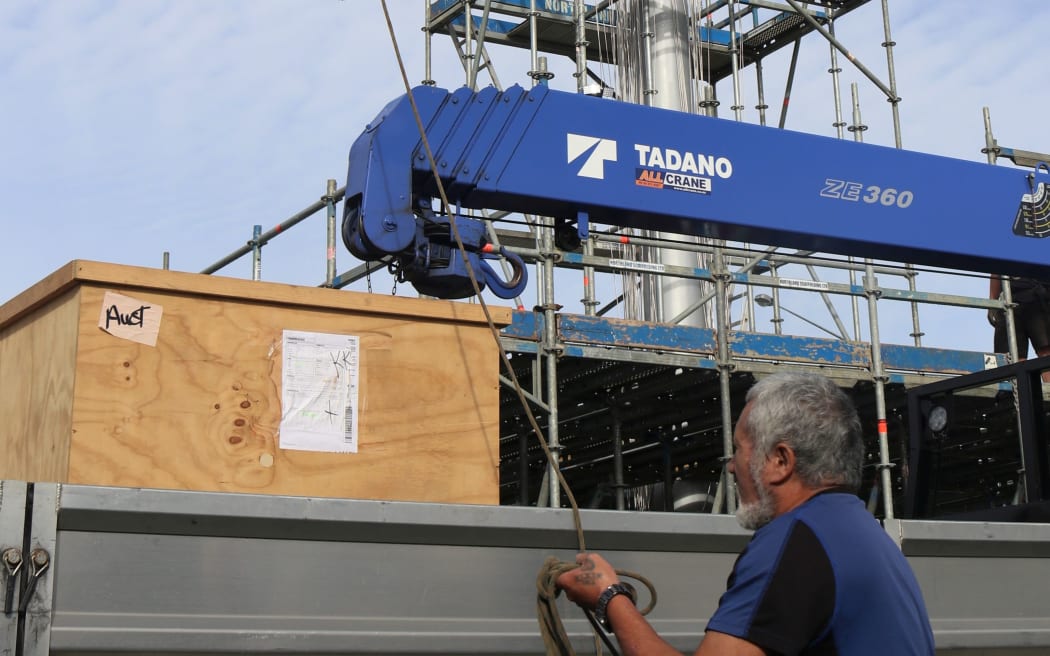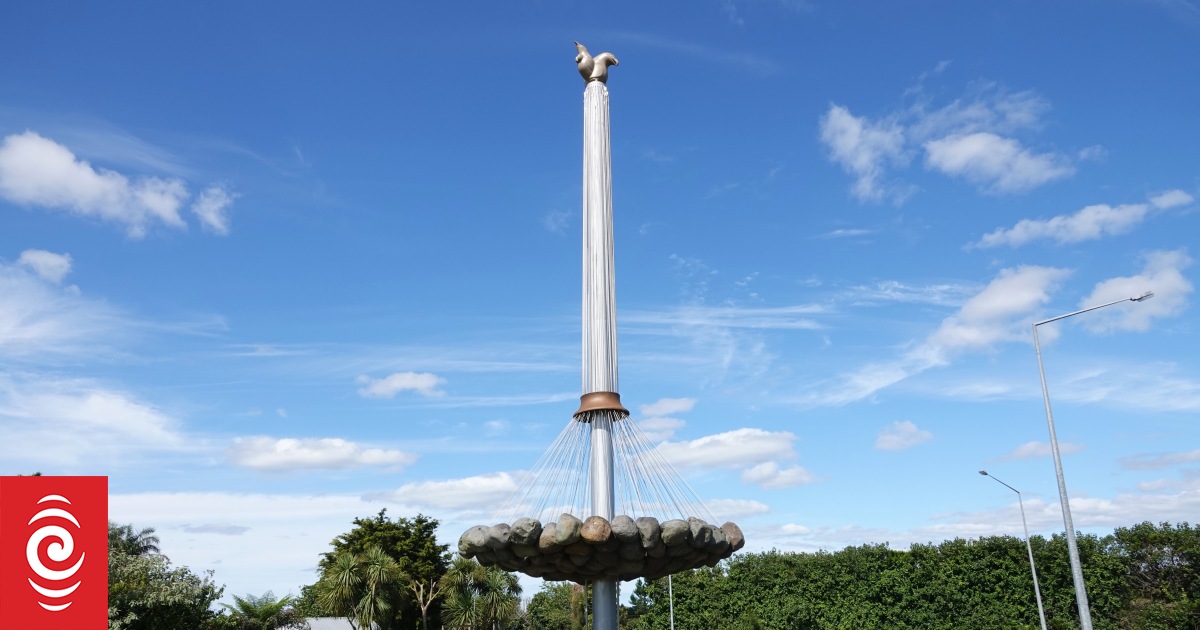
The Chris Booth sculpture Te Haa o Te Ao (The Breath of the World) dominates the entrance to Kerikeri.
Photo: RNZ / Peter de Graaf
A controversial climate-change-themed public artwork 13 years in the making is due to be completed in Kerikeri this week.
Te Haa o Te Ao, or The Breath of the World, by Chris Booth and Tom Hei Hei, comprises 120 boulders suspended from a 15-metre-high pole, capped by a birds’ head sculpture.
The final part of the artwork, a stone sign carved by Hei Hei welcoming visitors to Kerikeri in te reo Māori, is due to be installed on Thursday and unveiled early Friday morning.
The $500,000 sculpture was commissioned by local hapū Ngāti Rēhia and funded by a grant from the Covid-19 Response and Recovery Fund in 2020, along with a raft of other projects around Northland.
Booth, an environmental artist who has built large-scale artworks around the world, said it was the most trying project had been involved in, due to social-media-fuelled misinformation and repeated vandalism.
“Probably it’s the worst experience I’ve ever had in regards to any of my public sculptures. I did the Rainbow Warrior Memorial 33 years ago, the big gateway sculpture in Auckland’s Albert Park, the entranceway to Hamilton Gardens in the early 2000s, and Waka and Wave in Whangārei with Te Warahi Hetaraka. Obviously, there were some people [who] objected to those projects, there always are, but nothing like with this last year. It was just a nightmare.”
Booth said abuse from passing motorists started the day the scaffolding went up.

The repaired manu (bird) sculpture is returned to its roost at the top of Te Haa o Te Ao by, from left, Ngāti Rēhia leader Kipa Munro, hiab operator Brandon Peace and artist Chris Booth.
Photo: RNZ / Peter de Graaf
In the most serious incident, in April last year, vandals climbed the scaffolding, removed more than 60 cables, and damaged the birds’ heads.
It is thought the vandals used the steel cables to whip the bird sculpture, damaging the coating intended to protect it from the elements.
It had to be removed by crane and recoated, causing significant extra expense and delay.
“That was absolutely gut-wrenching for all of us, not just me, for my team for everybody associated with the project,” Booth said.
The attack occurred on a night of particularly vitriolic discussion on a community Facebook page.
Misinformation seen by RNZ on social media included false claims about who had commissioned the sculpture, how much it cost, that it had been paid for by the Far North District Council, and falsehoods about the artist.
There were even claims it was an electronic surveillance tower or a 5G cellphone tower in disguise.
Booth said another attempt at vandalism a few months later appeared to have gone awry.
The damage in that case was minor but the vandals left pools of blood where they appeared to have injured themselves trying to sabotage the boulders, each of which weighed more than 200kg.
Now the sculpture had been completed, the vitriol seemed to have vanished.

Artist Chris Booth.
Photo: RNZ / Peter de Graaf
Booth said he had spent many years promoting the sculpture around Kerikeri with Ngāti Rēhia trustee Nora Rameka, so he had been “on tenterhooks” about the final result.
“But I am very, very happy with it and really feel highly rewarded by the fact that a number of people have come to me saying how very happy they are about it as well,” he said.
The sculpture is part of a wider upgrade of the once shabby town entrance, which used to be dominated by advertising, tagging, tyre tracks and churned-up mud.
Now the billboards have been removed, the roundabout and roadsides have been landscaped, and a 12-tonne stone welcome sign will complete the project.
Originally Ngāti Rēhia wanted the sculpture built at Bulls Gorge, a few kilometres south on State Highway 10.
Later the location was shifted to the roundabout at the entrance to Kerikeri.
When Ngāti Rēhia was struggling to raise the money required, community group Our Kerikeri stepped in and applied to the Covid-19 Response and Recovery Fund.
Booth said anyone could have applied for a share of the funding, and he was delighted when the Ngāti Rēhia-Our Kerikeri application was successful.
He had ensured almost every dollar had been spent locally. The exceptions were the casting and coating of the birds, which could not be done in Northland.
Booth said the original inspiration for the sculpture was nearby Mount Pokaka, where Ngāti Rēhia used to signal to hapū on the Taiamai Plains about upcoming gatherings or that a battle was underway.
That led him to the idea for a sculpture at the entranceway to Kerikeri signalling a modern-day battle.
“The biggest challenge we have to face today is climate change. So when Ngāti Rēhia came to me 13 years ago with this huge honour, this is the design that I came up with.”
Booth said the kinetic sculpture represented local efforts to protect the environment.
If little or nothing was being done to combat climate change, a winch-operated bronze collar could be pulled down the column over the cables holding the boulders.
That would increase the tension in the cables and force the 30 tonnes of boulders to rise, representing a state of tension between humans and the natural environment.
If the collar was raised to the top of the column the boulders would hang freely at the same height, representing equilibrium with nature.
Booth said Far North schoolchildren would be tasked once a year with assessing the district’s environmental efforts and adjusting the position of the collar accordingly.

Sculptor Tom Hei Hei returns his cast manu (birds) to the top of Te Haa o Te Ao after damage by vandals in April 2022.
Photo: RNZ / Peter de Graaf
The bird sculpture on top of the column, by Tom Hei Hei, from Te Tii, featured a kāhu (hawk), tūī and kawau (shag).
The kāhu looked down the highway at visitors arriving in Kerikeri, the tūī gazed towards Puketi Forest and the kawau towards the sea.
In 2022, then Regional Economic Growth Minister Shane Jones hit out at the sculpture vandals and the ”Facebook scribblers” he said likely incited them.
Jones said Kerikeri had received a lot of money from the Provincial Growth Fund and its successor, the Covid-19 Response and Recovery Fund.
Other projects included the Waipapa roundabout, the new Kerikeri skatepark, the Kerikeri Domain playground, the upgrade of Te Ahurea (formerly Rewa’s Village) and a new sports facility taking shape on Waipapa Rd.
“The Kerikeri Facebook scribblers may dislike the statue but it came as part of an infrastructure package covering sports, transport, tourism and arts investments. I only hope that the dorks who vandalised the statue don’t further deface the new skateboard park,” Jones said at the time.




